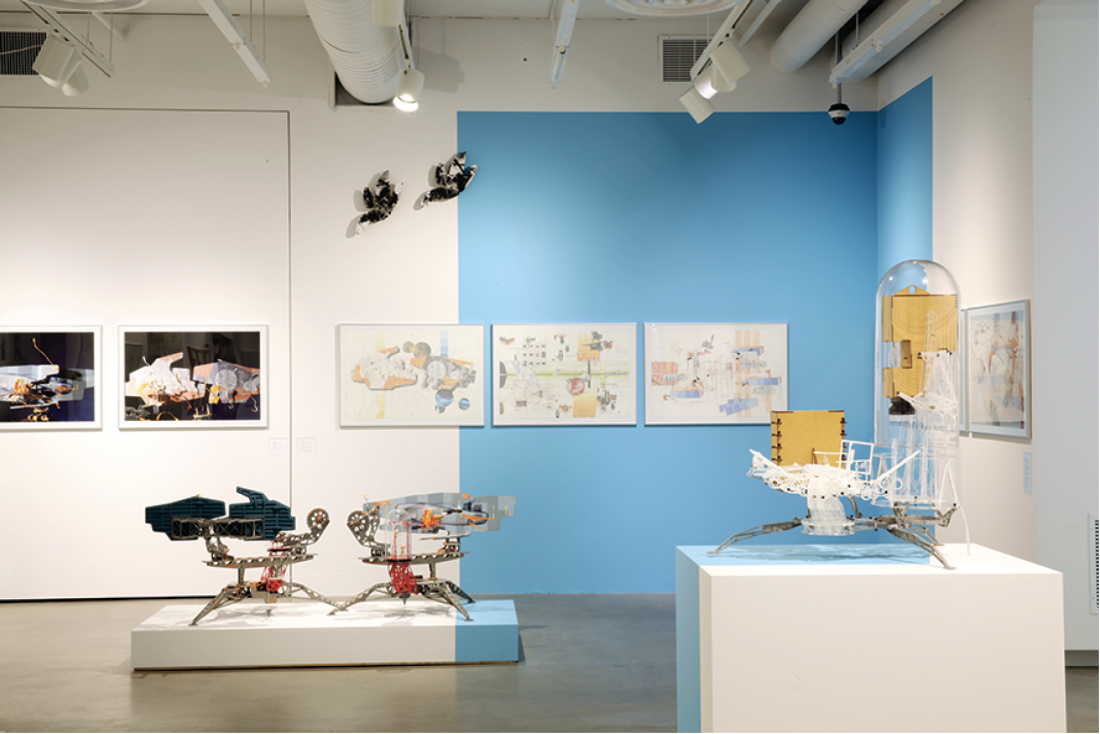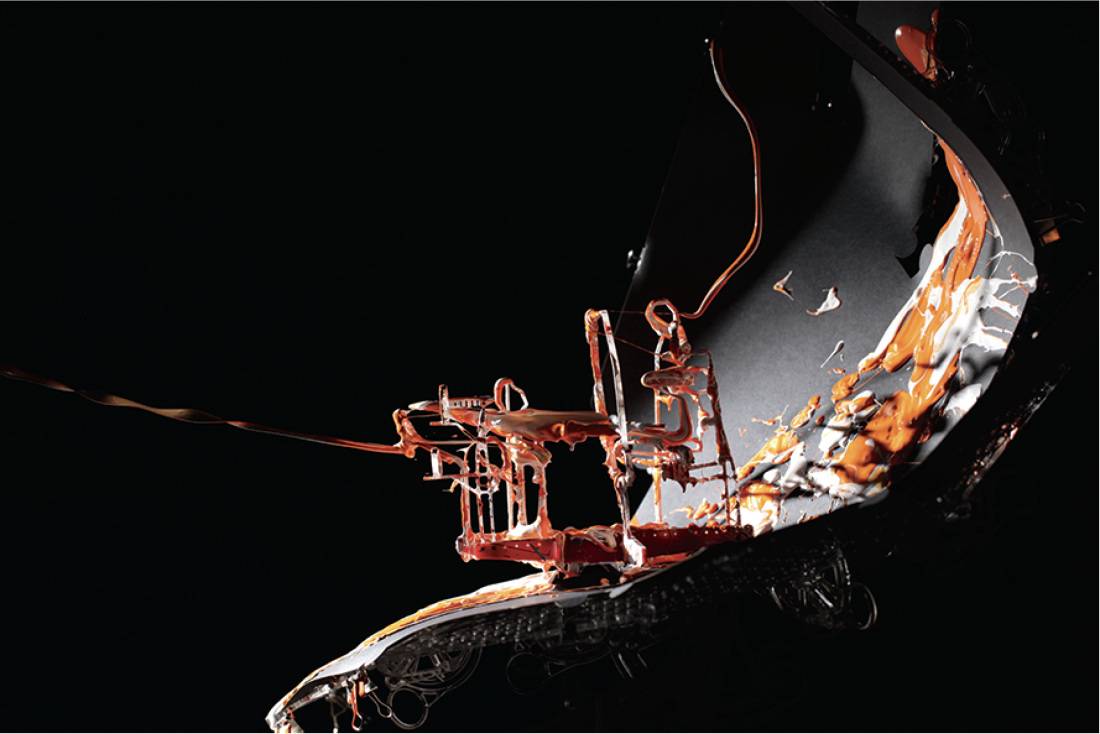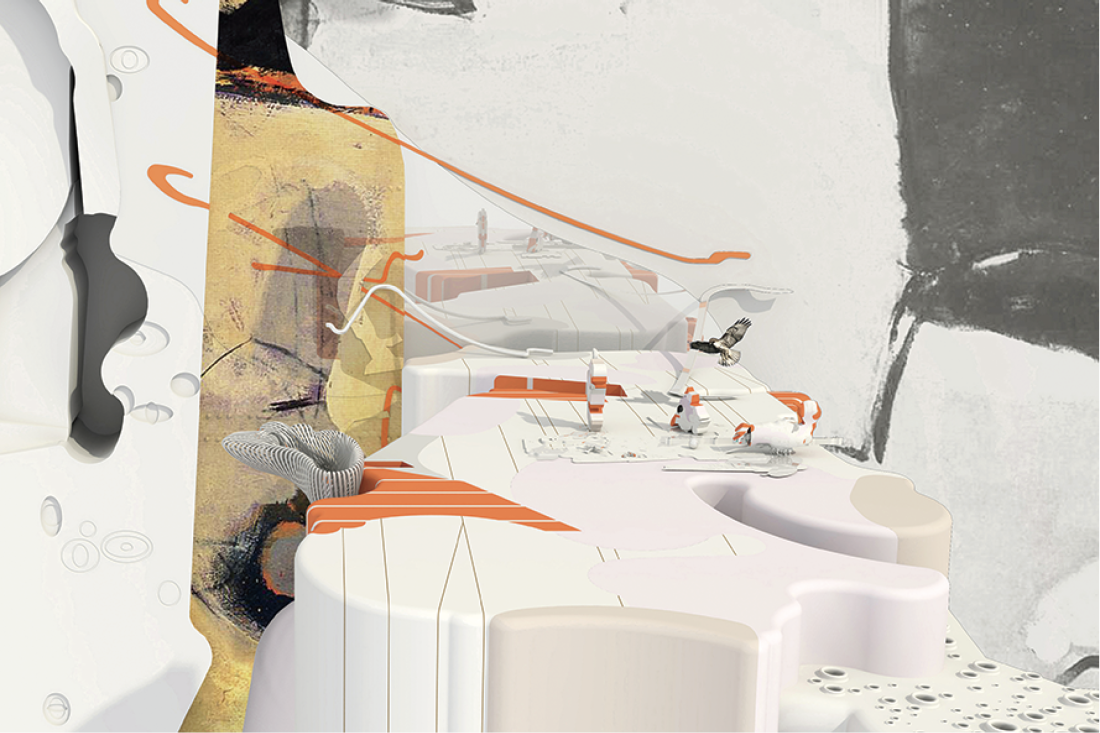Nat Chard and Perry Kulper
We are returned once more to the first form of the any-space-whatever: the disconnected space. The connection of the parts is not given, because it can come about only from the subjective point of view of a character who is, nevertheless, absent, or has even disappeared, not simply out of frame, but passed into the void. –Gilles Deleuze, Cinema 2 (University of Minnesota Press, 1989)
When saturation summons the analogical, metaphorical and rhetorical, evacuation retreats in the shadows of muteness, capitalizing on an aesthetics of disappearance…it may be that in the space of speculation, materiality is conceptual, duration malleable and gravity gone missing, opening the possibilities of spatial agency. –Perry Kulper, “Saturated Evacuations,” Dead on Arrival, 2009, editor Eduardo Aquino, Faculty of Architecture, University of Manitoba
“Unreliable Sightings of…” brought together the inquisitive architectural amusements of Nat Chard and Perry Kulper, proposing machines of perception for the survival of architecture both as an investigational tool, and as real propositions for a world construed through inexorable experience. Here architecture is understood as an open field of relational indeterminacy, challenging the sterile conventions of the manufactured artefact in the age of neo-liberal production. Atypically so, Chard-Kulper rendezvous with positions and technics that have more affinity with processes in sculpture, painting and performance than those related to the orthodoxy of representation and construction of buildings. This is an attempt to release architecture from the confinement of capital and the reductionism of marketable construction. In “Unreliable Sightings of…” we find drawings, drawing instruments, photography, digitalization of images, set-ups, models, choreographed situations—recombinant modes of uncertainty. These are articulated through relational thinking and iterative production. The work results in a landscape of possible new worlds where body and consciousness are concurrently implicated, where the phenomenon of this experience inhabits the space of avant-garde cultural approaches.

Installation view, “Unreliable Sightings Of…” 2015, Plug In ICA, Winnipeg.
The drawing machines of Nat Chard provide a measure of spatial perception that generate unexpected representations, producing radical intuition through the means of machine precision. Always referring, at the beginning of the experience, to the body, Chard’s work navigates through the accurately calculated purposes of the drawing machine, to produce the disconcerting situational characters of his representations. In the time in-between we encounter his paradoxical shadows where, in a moment of suspension, we find the exact point in-between experience and representation—even before the experience has been consummated. In Instrument Six, one of his illuminated drawing machines, a constructed, bowed plane supported by a three-legged chassis inscribes a grid onto which the shadow of an object is projected. Viewing through a pair of 3D goggles makes apparent that the shadow of the object is sitting at a short distance off the surface of the plane. This is evidenced by the relative position of the shadow to the drawing grid, just like Peter Pan’s shadow being cut off when Nana slammed the window shut and the shadow was left at the Darling house, hanging… Another moment of suspension is captured in his splattering machines, freezing in space and time a Pollockian splash, transforming in the process a paradoxical synchronicity: architecture / space + representation. This moment of suspended (dis)belief could qualify the whole gamut of Chard’s work—that we should always trust our own individual positions in face of the iconographic excess constantly being thrown back at us, making us in this case, engaged agents within the work, within the world.
Perry Kulper’s drawings remain at the centre of his discursive practice. These are not simple drawings with singled-out messages, but they develop worlds of imagination within the realm of architectural constructability, where architectural signifiers like lines, dots, doors, walls, buildings, roads and landscapes are recognized but are instantly hovering in a continuum of time-space intricacy within the surface of representation. Kulper’s drawings take the eye into the make-believe world just like the archival ghosts from a story by Jorge Luis Borges. Architecture’s specificity coalesces into buildings of mind and cities of perception, absorbing the unsuspected eye into the experience of seeing, relative to the palimpsest of real-life spaces. In Kulper’s drawings the eye, linking point to point in contiguity, from architectural situation to architectural situation, creates the chance to build individual captures of space, wherever that space might be.

Nat Chard, Instrument Five in action, 2010, acrylic, paper and latex paint, high speed flash photograph, dimensions: each instrument fits within a one-metre cube.
Together they made two instruments, “Archival Ghosts” and “Paradoxical Shadows,” designed by Chard, inhabited by Kulper, performed by both. The instruments supported their drawings, holding the contents under glass domes, which in the process threw latex paint at each other. The drawing pieces are the objects that the paint is aimed at, that causes the splatter to occur, which lands on the drawing surface. They had been looking at ways of collaborating that include their various methods of working without containing them in the methods of the other. In Chard’s construction, the throw of paint stands for an indeterminate occupation and the drawing pieces are an architecture, but in a form of representation that understands that it will be occupied by paint, that is in place of people, where the actual “site” could be a drawing by Kulper. Hence representation and experience concomitant in time and space.
The pleasure of Chard-Kulper’s work is born of the negation of architecture as a matter-of-fact apparatus, turning its own making into an act of creation and audacity through moments where unfixed sequences of material combination are worked through accuracy and love. The work is a relentless continuum of speculations that involve the investigation of surfaces, spaces, visualities, relations and representations, never isolating one from the other but bringing perception together as an occurrence in synchronicity with the body—fluent and expansive rather than formulaic or abbreviated.

Perry Kulper, Miniature + Hawks, Fast Twitch: Speculative Desert Dwelling, 2012, digital rendering, 24 x 36 inches, by Sen Liu.
A scientist goes back to his work, night after night, not because he is suffering but because he wants to see the results. He can’t make himself sleep, and instead he stays up late into the night immersed in the question, studying the implications of what is available, occupied by the attention and the energy that moves the careful and passionate study of things, independent from the pressures of production or obligations of social morality, but moved by the desire to communicate the incommunicable. They carve a space in architectural culture that sustains the idea that invention is still the essential material for architecture’s own endurance. Moreover, social and cultural anthropologist Arjun Appadurai would concur that this is a time where extreme pragmatism and global generalizations asphyxiate meaning, when architecture is liquidated into simplistic commodification—the very thing that constructs a homogenizing sense in the generic perception of things. Extreme pragmatism can also lead to a cultural strabismus, reducing architecture to the resolution of practicalities—the fallacy of shrinking it into a “problem-solving” discipline. In the case of Chard-Kulper the entry into the realm of “making architecture” comes from the back door of pragmatism: architecture primarily as life experiment, invention and poetry, along with the authentic obsession that corrects the misleading advances of cultural reductionism. Poetry and science are taken as a gradual, paced, careful construction of systems that together create a space of saturation and indeterminacy. These qualities are what keeps the work alive and active, providing spatial agency to whomever comes in contact with it. By relying on procedures more often identified with artistic attitudes, the work makes architecture free and dynamic again through experiments that destabilize the idea of “building,” proposing new ways of architectural thinking and making. ❚
“Unreliable Sightings of…” was exhibited at Plug In ICA, Winnipeg, from July 4 to August 30, 2015.
Eduardo Aquino works in the expanded field of art & architecture under spmb. He is an Associate Professor at the Faculty of Architecture, University of Manitoba, and has been awarded by the National Arts Foundation of Brazil (FUNARTE), and the Royal Architectural Institute of Canada (RAIC).

